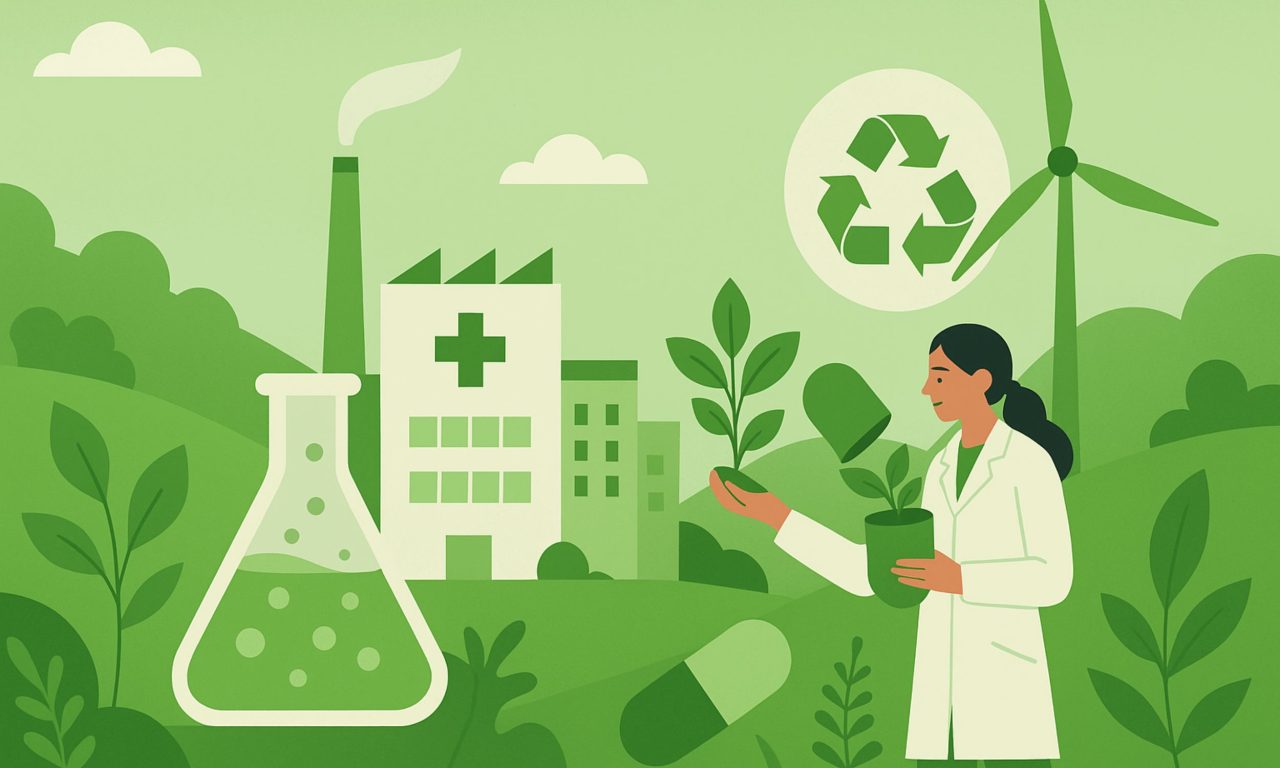The global pharmaceutical industry has long stood as one of humanity’s most vital sectors—delivering vaccines, antibiotics, and therapies that extend lives. Its environmental footprint, however, has remained conspicuous.
A 2019 study by the University of Waterloo, Canada, found that the pharmaceutical industry’s emission intensity averaged 48.55 t CO₂e per USD million of revenue – about 55 percent higher than the automotive sector. In total, the industry emitted around 52 million t CO₂e that year, exceeding the entire automotive industry’s footprint.
Healthcare, overall, contributes 4.4 percent of global GHG emissions, with pharmaceuticals responsible for roughly a quarter of that total.
But in 2025, there has been signs of perceptible resolution and reinvention in this vital sector.
The Chemistry Problem: Solvents, Synthesis and Carbon
Behind every drug lies a trail of chemical reactions – many of which are reliant on petroleum-based solvents. These solvents account for up to 70 percent of process emissions and 80–90 percent of total waste mass.
According to McKinsey, around 70 percent of APIs are made from fossil-fuel feedstocks, with one-quarter of a company’s overall carbon footprint often tied to API production. Disposal of spent solvents alone adds 2-4 kg CO₂ per kg of solvent used.
To counter this, the pharma industry is adopting green chemistry: bio-based solvents, water-based systems, and continuous-flow reactors that shrink reaction times and energy use. Cornell University and the Clinton Health Access Initiative found that cleaner solvents, renewable energy, and improved logistics in one HIV-drug supply chain cut its carbon footprint by nearly 45 percent. Takeda’s Vienna plant demonstrates what’s possible – a 90 percent cut in energy-related emissions through heat-pump integration and waste-heat recovery.
Packaging Re-imagined
Packaging is pharma’s most visible sustainability challenge. Multi-layer blister packs combining PVC, PVdC, and aluminium foil are notoriously hard to recycle. The global pharmaceutical-packaging market, worth over USD 100 billion, could reach USD 160 billion by 2030, driven largely by the shift toward eco-friendly materials. Major players are experimenting with recyclable and compostable designs:
- GSK: mono-material polypropylene packs
- Pfizer & Sanofi: cellulose-based compostable films
- AstraZeneca & Huhtamaki: paper-based or bio-PE packaging
The stakes are high. A UK NHS analysis showed that an IV antibiotic’s carbon footprint was 60 times higher than an oral tablet, primarily due to packaging and disposal impacts.
The Water Footprint: from Neutrality to Positivity
The global pharma industry extracts roughly 9 billion m³ of water every year, including in many water-stressed regions. Antibiotic residues and chemical effluents in wastewater have also been linked to the rise of antimicrobial resistance (AMR).
In order to mitigate the challenge, leading firms are targeting water-neutral or water-positive operations:
- Novartis India recycles more than 90 percent of its process water
- AstraZeneca Bengaluru operates on zero-liquid discharge
- Pfizer Vizag reuses 75 percent of wastewater via membrane bioreactors
The Pharmaceutical Supply Chain Initiative (PSCI) now requires suppliers to disclose usage of water, thereby making accountability a part of the deeper value chain.
Net-Zero Roadmaps: Science-Based Transformation
After the Paris Agreement, big pharma aligned with science-based targets (SBTi) to cap warming at 1.5 °C.
| Company | Net-Zero Target | Highlights |
| AstraZeneca | 2030 (value chain) | 100 % renewables; Scope 1 & 2 zero by 2025 |
| GSK | 2030 (manufacturing) | Carbon-neutral operations |
| Novartis | 2040 (value chain) | Net-zero ops by 2025 |
| Pfizer | 2040 (all scopes) | 60 % direct-emission reduction since 2000 |
Renewable Energy and Decarbonised Supply Chains
HVAC systems, refrigeration, and sterile-room energy loads make pharma one of the most power-hungry industries. Transitioning to renewables is therefore transformational. Novo Nordisk’s Kalundborg site runs entirely on farm-sourced biogas, reducing emissions by a half. Takeda, Bayer, and Roche have already equipped several plants with 100-percent renewable energy.
Cold-chain logistics also matter, as they can account for 10 – 12 percent of lifecycle emissions. Pfizer’s Green Logistics Program and AstraZeneca’s adoption of sustainable aviation fuel show how carbon can be squeezed out of transport networks.
Circular R&D and Digital Innovation
Digitalisation is greening the lab bench. AI-assisted molecular modelling identifies low-waste synthesis routes; robotic micro-reactors cut solvent use by 90 percent.
Pfizer’s deployment of digital-twin systems across 20 facilities saved 200 GWh of energy in two years. Meanwhile, the Solvent Eco-Impact Metric quantifies solvent harm, guiding greener substitutions.
The Regulatory Push and Investor Pressure
Regulation is tightening:
- EU Green Deal and Carbon Border Adjustment Mechanism will extend to intermediates
- India’s Business Responsibility and Sustainability Reporting norms compel listed firms to disclose ESG data
- U.S. Inflation Reduction Act incentivises domestic low-carbon manufacturing
India’s Green-Pharma Awakening
As the “Pharmacy of the World,” India produces one in every five generic medicines globally and supplies 60 percent of global vaccine demand. But its production hubs such as Hyderabad, Vishakhapatnam, Ankleshwar, and Baddi face water-stress and pollution challenges.
The Department of Pharmaceuticals’ Green Chemistry Initiative under Pharma Vision 2030 promotes cleaner synthesis, solvent recovery, and energy-efficient plants. The Central Pollution Control Board (CPCB) has issued draft guidelines to curb antibiotic effluent, addressing AMR at the source.
Indian majors are already leading the way:
- Dr. Reddy’s Laboratories has cut specific energy consumption by 25 percent since 2018 and targets 100 percent renewables by 2030
- Cipla achieved water-positive status at multiple sites and joined the global Race to Zero campaign
- Sun Pharma introduced solvent-recovery units capable of reclaiming 80 percent of used chemicals
Various state governments are also greening industrial clusters. For example, Telangana’s Pharma City Project mandates zero-liquid-discharge common effluent-treatment plants (CETPs) and shared renewable infrastructure.
India’s leadership is not only about compliance – it is becoming a strategic export advantage as Western buyers demand low-carbon supply chains.
Beyond Compliance: Innovation from the Global South
India’s shift mirrors a wider trend across emerging markets. Vietnam’s growing API industry, South Africa’s biologics hubs, and Brazil’s formulation clusters are integrating green chemistry and renewable energy to meet ESG expectations.
What differentiates India is scale and speed. The country’s Green Pharma Summit 2024 brought together more than 300 manufacturers, pledging to adopt Life-Cycle Assessment tools and set Scope 3 targets by 2026.
Domestic innovators are developing enzyme-based synthesis, bio-solvents from sugarcane waste, and recyclable PET blister packs. Venture funds such as Bharat Innovation Fund and IvyCap Ventures are channelling capital into start-ups working on low-energy filtration membranes and waste-heat recovery modules.
Cleaner chemistry protects not just the planet but also people. Studies by Health Care Without Harm Europe show that unmanaged pharmaceutical effluents damage aquatic ecosystems and propagate antimicrobial resistance.
In India’s Hyderabad cluster, local NGOs such as Pure Earth India and Hyderabad Urban Lab have begun tracking pharma effluents – an effort now supported by state pollution boards. Worker safety standards are improving as solvent exposure declines under green-manufacturing protocols.
Challenges on the Path to Sustainability
The obstacles are real:
- Capital cost: continuous-flow reactors and solvent-recycling units require multi-million-dollar investments
- Regulatory lag: process changes trigger re-validation
- Data fragmentation: suppliers rarely disclose full emissions data
McKinsey estimates that while 70 percent of API manufacturers have climate targets, only 20 percent have detailed action plans. And compostable packaging can backfire in markets lacking recycling or composting infrastructure.
Collaborations and Coalitions for Change
Industry alliances are multiplying:
- Pharmaceutical Supply Chain Initiative (PSCI) standardises supplier audits
- AMR Industry Alliance coordinates wastewater management
- UN Global Compact Health Platform links pharma decarbonisation to the SDGs
In India, CDRI, CSIR, and Pharmexcil are exploring a National Green-Chemistry Network to share technology and benchmarking data across public and private labs.
Public-private innovation hubs like the U.K.’s Innovate Pharma CleanTech Hub and India’s Atal Innovation Mission are now co-funding enzyme-based synthesis research – fusing global and Indian expertise.
Toward a Circular Pharma Economy
Pharma’s endgame is circularity:
- Solvent-recycling loops reuse recovered chemicals.
- Reverse-logistics systems recollect unused medicines.
- Reusable delivery devices, such as Novo Nordisk’s PenCycle, are cutting plastic waste by 150 t a year
Such initiatives align with the UN Sustainable Development Goals 12 and 13 on responsible consumption and climate action.
Technology, Talent and Transparency
Institutions like IIT-Bombay and NIPER-Mohali now run electives on Sustainable Pharmaceutical Engineering. Digital dashboards allow real-time tracking of emissions, while blockchain-based traceability ensures supply-chain transparency.
The emerging discipline of “carbovigilance” – systematic carbon-footprint monitoring in drug manufacturing – may soon become a regulatory requirement.
The Road Ahead: Resilient, Regenerative, Responsible
Pharma’s sustainability revolution is gathering momentum. Renewable power, recycled solvents, green logistics, and circular packaging will define the 2030 playbook.
The payoff is multi-dimensional: lower operational costs, stronger brand equity, and supply-chain resilience in an era of climate disruption.
By 2030, the phrase green pharma will describe not a niche initiative but a new industrial baseline.
Conclusion: Healing the Planet while Healing the People
From greener solvents to recyclable packaging and water-neutral plants, the pharmaceutical sector is rewriting its chemistry with conscience. The next decade will test its resolve—but also redefine its role in global sustainability.
As AstraZeneca CEO Pascal Soriot said at COP 28: “The health of humanity depends on the health of our planet.” India, standing at the intersection of affordability and innovation, may yet lead this revolution.


